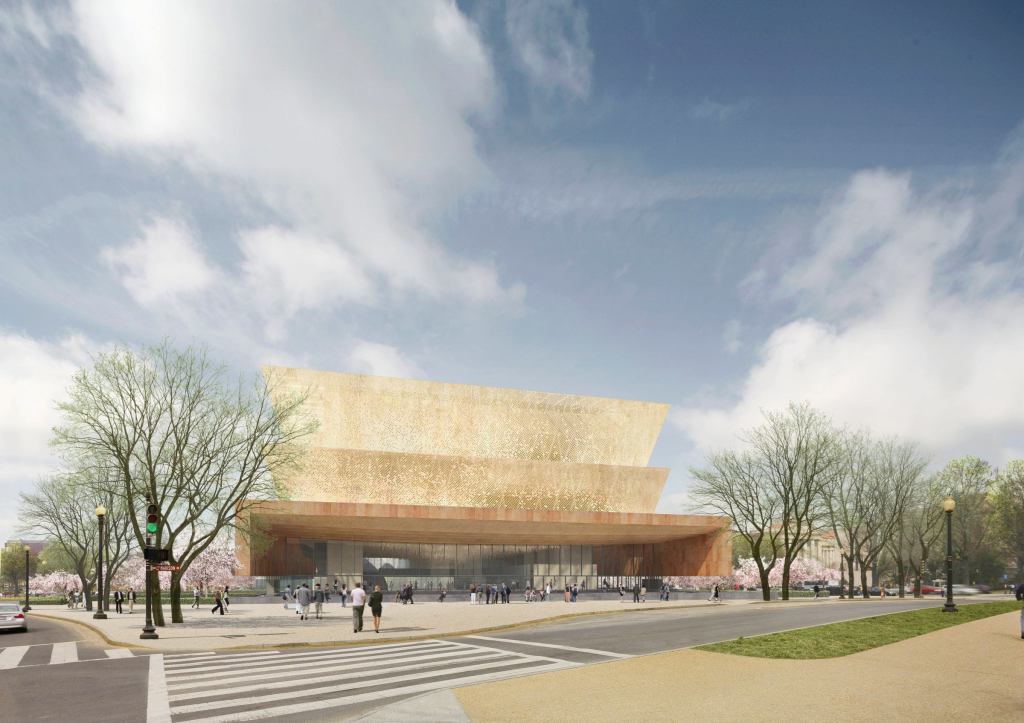The National Mall: Marian Anderson sang there, Martin Luther King Jr. marched there, and last January Barack Obama received the oath of office on the Capitol steps, overlooking millions of people standing in what is often called “America’s Backyard,” but what is also one of African-American history’s most important sites.
That reputation was underlined yet again in April, when the Smithsonian Institution announced the winning design for the $500 million National Museum of African American History and Culture (NMAAHC). When it opens in 2015, the museum will be the official institution of the black experience in America.
What should such a museum look like? Should its architecture express, somehow, the program it encases? There is a worrying precedent. At the other end of the Mall sits the National Museum of the American Indian, a kitschy pile that, by literally writing its program in its faux-adobe structure, ends up saying very little about the myriad cultures that make up the Native American community. After all, what does adobe have to do with the Iroquois?
Yet it is hard to argue the opposite, that these museums should make no effort to express their program; most of the other museums on the Mall already do. The National Air and Space Museum is a Space-Age box, while the National Gallery’s East Building is a Modernist home for modern art. And so the question facing the NMAAHC is this: What is the appropriate style for an institution dedicated to African-American history and culture—particularly in the 21st century and the age of Obama?
The winning design comes from the team of David Adjaye, Philip Freelon, and Davis Brody Bond Aedas (whose contribution was led, until recently, by the late Max Bond). All three are exceptional and well-respected black architects, and their design, inverted bronze 3D trapezoids atop a granite plinth, was the exact combination of uniqueness and convention the Smithsonian was looking for. (After his death, Bond’s spot was taken over by his protégé in the firm, Peter Cook.) While details of the plan are likely to change, both the Smithsonian and the architects say these two elements are nonnegotiable.
The design treads into an ongoing debate over the appropriateness of African architectural elements in contemporary design. According to the NMAAHC architects, the inverted trapezoids, derived from a Yoruban column or crown, stand for Africa and the international African diaspora; the plinth, open at both ends, stands for the porch, a common element in the southern African-American vernacular. (Interestingly, while the winning design made the most literal use of African and African-American design tropes, others—including Norman Foster’s snail-like proposal—were narrative-driven: Visitors would progress through history as they progressed through the museum.)
The African-American architectural community is deeply split between those, like Kent State’s David Hughes, who believe an Afrocentric architecture can and should be found, and those, like critic Darrell Fields, who believe black culture is too multifarious for a single set of aesthetic elements to embody the entirety of its experience.
Bond himself said, in an interview with the late Architectural Record editor Stephen Kliment, “Afrocentrism, to the extent that it implies a unitary culture, is an oversimplification.” By drawing on particular stylistic tropes from particular parts of western Africa and the American South, the NMAAHC architects run the risk of isolating the vast array of other African-American experiences.
Even riskier, though, is the architects’ decision to make the museum an expression not only of African-American history, but the global African diaspora as well. Adjaye, the London-based, Tanzania-born son of a Ghanaian diplomat, is himself a product of that diasporic culture, and he has spoken eloquently about the need for the museum to connect not only with people of African descent in America, but around the world. But why should that be the job of a museum on the Mall?
The design is a risk, but it should work. The elements are too abstract to be kitsch, yet they are specific enough to catalyze the experience of the museum’s program. The real brilliance, though, is the balance between the American and the Yoruban vernacular, which resolves the concerns that each would raise alone. The American vernacular plinth grounds the diaspora-inspired elements, while the Afrocentric trapezoid underlines the timeless themes that lie at the core of African-American culture and history: the pains of transplantation, the struggle for identity, the conflict between majority and minority ethnic groups.
The design succeeds because, through that balance of symbolic elements, it speaks to both a particular history and a universal set of experiences. It expresses the museum’s mission perfectly: to explain the African-American story, but at the same time explain why it is an American—indeed, a global—story.
At a time when America’s president is the son of a white American and a black Kenyan—a man who is the living embodiment of black, white, and international traditions—our cultural institutions must likewise speak simultaneously to the particular and the universal, the diverse and the collective whole. The National Museum of African American History and Culture will be the first, and hopefully not the last, to do just that.
